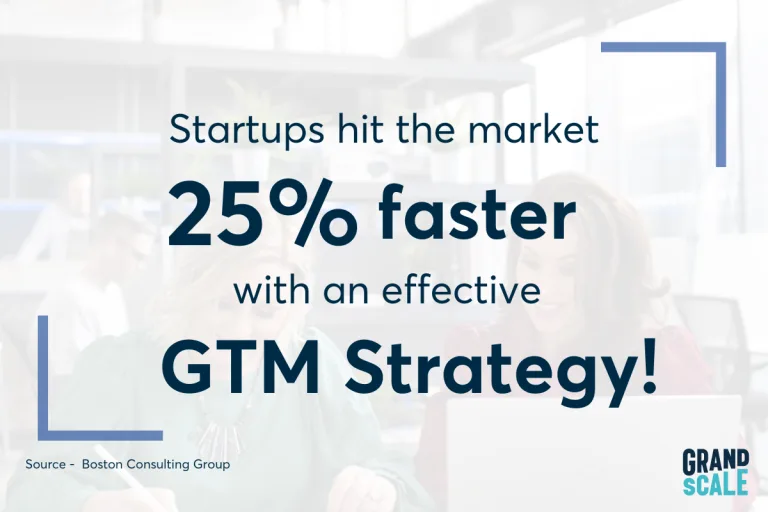
How Can Go-To-Market Strategies Accelerate Startup Growth?
As a startup, you’re ready to conquer new heights. You’ve got an innovative solution and a passionate team. But here’s the thing—without a strategic Go-to-Market (GTM) plan, even the best ideas risk getting lost in the noise.
A GTM strategy is more than just a business add-on; it’s the GPS guiding you towards scalable success. It acts as a roadmap that aligns your product or service with the right market, at the right time, with the right message.
Let’s explore how a strong GTM strategy gives you the edge to move fast, stand out from your competitors, reach the right customers and attract investors. Ready to make your mark?
1. Target with Precision: Find and Focus on Your Ideal Market
Casting a wide net might feel like the answer, but for startups, focus is everything. A solid GTM plan zeroes in on the customers with the most to gain from your solution.
Slack, for example didn’t try to appeal to every business when it launched. Instead, it focused on small teams and departments within companies that struggled with fragmented communication tools. Slack’s initial target market had a clear pain point: they were bogged down by disjointed communication, using email, chat apps, and file-sharing tools that weren’t integrated.
By offering an all-in-one communication platform that streamlined team collaboration, Slack solved a specific problem for a well-defined audience. This targeted approach quickly gained traction, helping Slack reach 15,000 daily active users within weeks of launching, before expanding into larger organisations.

Lesson? Nail down a clear target market from the start, and you’ll be better positioned for growth.
2. Differentiate and Dazzle: Highlight What Sets You Apart
In today’s world, “just good” doesn’t cut it. A well-defined value proposition—an essential element of your GTM strategy— is your opportunity to shine and showcase what makes you different.
Dropbox nailed this by offering a seamless, user-friendly file-sharing experience when alternatives were clunky. By positioning itself as the easy-to-use option with free storage, Dropbox set itself apart from competitors, capturing its target audience and growing from 1 million registered users in just two years to over 700 million by 2021, ultimately defining the market.

Lesson? Make sure your strategy spells out exactly why you’re the better choice – what makes your solution better, faster, or more valuable than existing alternatives.
3. Maximise Resources: Make Every Penny Count
For startups, every pound counts. A clear GTM strategy directs your budget and time towards what matters most—whether that’s targeting the right customers, refining your sales approach, or optimising your marketing spend.
HubSpot, for instance, initially focused on small to mid-sized businesses, offering affordable marketing tools that met their needs. This focus helped them grow without overspending on untargeted marketing efforts, with revenue soaring to £1.3 billion by 2023.

Lesson? Maximise impact by doing more with less. Focus your efforts on the right customers and key activities to drive scalable growth without overspending.
4. Launch Faster: Gain Traction, Get Feedback, Grow
Speed is critical for startups. A GTM strategy accelerates your launch by providing a clear roadmap for executing your product release, gaining early customer feedback, and iterating quickly.
Zoom did exactly that, initially targeting small businesses needing reliable video conferencing. Their clear focus and execution led to explosive growth, with the company going public in 2019 at a $9 billion valuation and reaching over 300 million daily meeting participants by 2020.

Lesson? Develop a GTM strategy to fast-track your product launch, then use early customer feedback to refine your offering and fuel faster growth.
5. Attract Investors: Prove You’re Worth the Investment
Investors want to see a clear path to growth. A GTM strategy shows them you’ve thought through your market, value proposition, and the steps to scale sustainably.
Take Airbnb—they knew budget-conscious travellers and homeowners with extra space would be their core users. With this well-defined market and a unique value proposition, they quickly gained traction, raising significant funding along the way to fuel their global expansion.

Lesson? Craft an executable GTM plan to demonstrate to investors that you have a strategic approach and can mitigate risks, making you a more attractive investment.
Your Next Step: Download Our Free GTM Guide
As an entrepreneurial education business supporting innovative ventures, we’ve seen first-hand how a solid Go-to-Market strategy can drive startup growth.
Ready to gain early traction and set your startup up for long-term success? Download our free GTM guide to kickstart your journey with the tools and insights you need. Let’s make your vision a reality—step by step.



